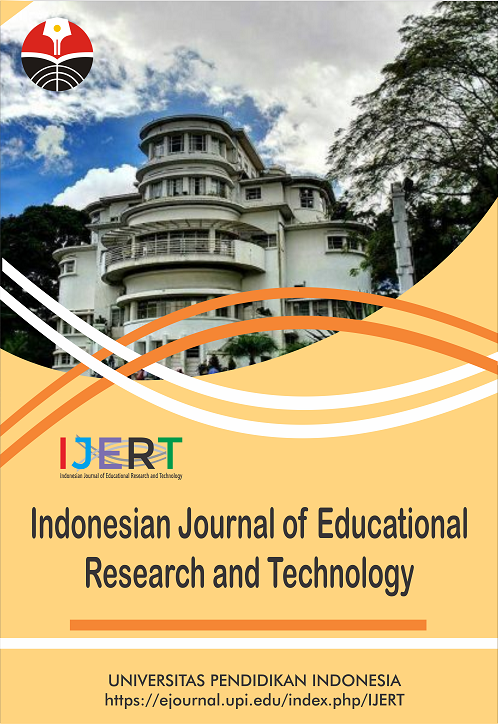Factors Affecting Distance Learning of the Physical Education Students of Sultan Kudarat State University, Mindanao, Philippines
Abstract
Keywords
Full Text:
PDFReferences
Abdous, M. H., and Yen, C. J. (2010). A predictive study of learner satisfaction and outcomes in face-to-face, satellite broadcast, and live video-streaming learning environments. The Internet and Higher Education, 13(4), 248-257.
Baisley-Nodine, E., Ritzhaupt, A. D., and Antonenko, P. D. (2018). Exploring social presence within an online course using Twitter. E-Learning and Digital Media, 15(5), 235-253.
Chen, Y. H., and Jang, S. J. (2019). Exploring the relationship between self-regulation and TPACK of Taiwanese secondary in-service teachers. Journal of educational computing research, 57(4), 978-1002.
Cole, A. W., Lennon, L., and Weber, N. L. (2021). Student perceptions of online active learning practices and online learning climate predict online course engagement. Interactive Learning Environments, 29(5), 866-880.
Dias, S. B., Hadjileontiadou, S. J., Diniz, J., and Hadjileontiadis, L. J. (2020). DeepLMS: A deep learning predictive model for supporting online learning in the Covid-19 era. Scientific Reports, 10(1), 1-17.
Ghazi-Saidi, L., Criffield, A., Kracl, C. L., McKelvey, M., Obasi, S. N., and Vu, P. (2020). Moving from face-to-face to remote instruction in a higher education institution during a pandemic: Multiple case studies. International Journal of Technology in Education and Science, 4(4), 370-383.
Grieve, R., Indian, M., Witteveen, K., Tolan, G. A., and Marrington, J. (2013). Face-to-face or Facebook: Can social connectedness be derived online?. Computers in Human Behavior, 29(3), 604-609.
Henriksen, K., Schinke, R., Moesch, K., McCann, S., Parham, W. D., Larsen, C. H., and Terry, P. (2020). Consensus statement on improving the mental health of high performance athletes. International Journal of Sport and Exercise Psychology, 18(5), 553-560.
Hirumi, A., Sivo, S., and Pounds, K. (2012). Telling stories to enhance teaching and learning: The systematic design, development and testing of two online courses. International Journal on E-Learning, 11(2), 125-151.
Kyei-Blankson, L., Ntuli, E., and Donnelly, H. (2019). Establishing the importance of interaction and presence to student learning in online environments. Journal of Interactive Learning Research, 30(4), 539-560.
Lazarevic, B., and Bentz, D. (2021). Student perception of stress in online and face-to-face learning: the exploration of stress determinants. American Journal of Distance Education, 35(1), 2-15.
Lowenthal, P. R., and Dunlap, J. C. (2014). Problems measuring social presence in a community of inquiry. E-Learning and Digital Media, 11(1), 19-30.
Malik, M. E., Danish, R. Q., and Usman, A. (2010). The impact of service quality on students’ satisfaction in higher education institutes of Punjab. Journal of Management Research, 2(2), 1-11.
Martínez-Argüelles, M. J., and Batalla-Busquets, J. M. (2016). Perceived service quality and student loyalty in an online university. International Review of Research in Open and Distributed Learning, 17(4), 264-279.
Otter, R. R., Seipel, S., Graeff, T., Alexander, B., Boraiko, C., Gray, J., and Sadler, K. (2013). Comparing student and faculty perceptions of online and traditional courses. The Internet and Higher Education, 19, 27-35.
Shin, M., and Hickey, K. (2021). Needs a little TLC: Examining college students’ emergency remote teaching and learning experiences during COVID-19. Journal of Further and Higher Education, 45(7), 973-986.
Stavredes, T. (2011). Overcoming physical separation in the online environment to help learners persist. InSight: A Journal of Scholarly Teaching, 6(1), 9-13.
Vanslambrouck, S., Zhu, C., Lombaerts, K., Philipsen, B., and Tondeur, J. (2018). Students' motivation and subjective task value of participating in online and blended learning environments. The Internet and Higher Education, 36, 33-40.
Widjaja, A. E., and Chen, J. V. (2017). Online Learners’ Motivation in Online Learning: The Effect of Online-Participation, Social Presence, and Collaboration. Learning Technologies in Education: Issues and Trends, 12, 72-93.
DOI: https://doi.org/10.17509/ijert.v1i3.41413
Refbacks
- There are currently no refbacks.
Copyright (c) 2021 Universitas Pendidikan Indonesia

This work is licensed under a Creative Commons Attribution-ShareAlike 4.0 International License.







.png)




